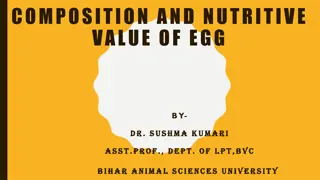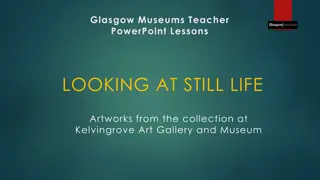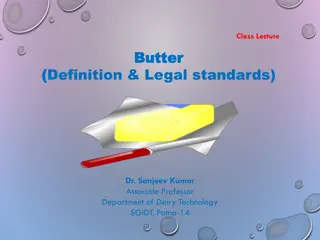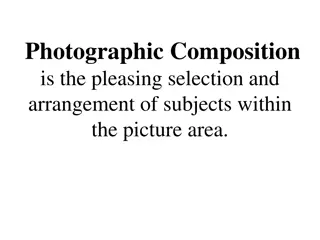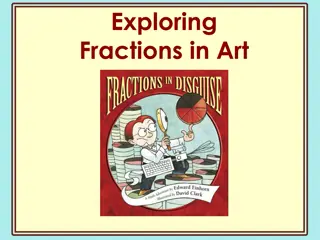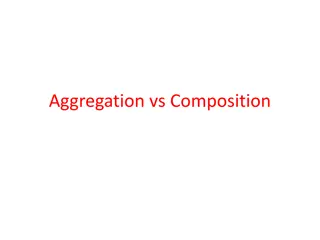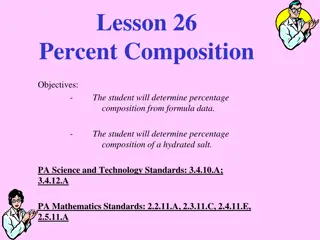Understanding Composition in Art: Techniques and Examples
Explore the concept of composition in art through various styles such as abstract, naturalistic, and stylized representations. Learn about the vocabulary and skills necessary for effective composition, with examples from renowned artists like Leonardo da Vinci, Georges Seurat, and more. Discover how composition plays a crucial role in creating visually appealing artworks.
Download Presentation

Please find below an Image/Link to download the presentation.
The content on the website is provided AS IS for your information and personal use only. It may not be sold, licensed, or shared on other websites without obtaining consent from the author. Download presentation by click this link. If you encounter any issues during the download, it is possible that the publisher has removed the file from their server.
E N D
Presentation Transcript
Black and White Week 1-2 Composition Shape Style: Abstract, Naturalistic, Stylized
Vocabulary and Skills Vocabulary Abstract Style Naturalistic-Realistic-Representational Style Stylized Image Positive and Negative Shape Biomorphic-Organic/Geometric Notan Ma Renaissance, Modern Art, Zen Skills: Perceiving Darkness and Light Ability to see and make effective compositions Appreciation for Art History Next Two weeks: Typography, Calligraphy and Figure/Ground
Common styles Naturalistic or Realistic Representation Leonardo da vinci Drapery Study Andrew Wyeth
Abstracted Representation Franz Marc on the left and Pablo Picasso on the right.
More Abtracted Representation: Paul Klee 20th Century European 19th-20th Century Tlingit Ceremonial Robe (Native American)
What is composition? Or what is the act of composing?
Composition can be: additive, a building up. It can be both a priori (before we start) and developed in the process of making (through thumbnails or experimentation.) Composition can be: subtractive including cropping or deleting. It can be altering after the fact this is something you already do, especially in digital formats. However this seems to be All students do these days in terms of editing. Composition is always the abstraction that underlies any work, be it representational, abstract or stylized. Your work will be better if you can think of composition as a part of all works, at all parts of the project. It is a creative tool with you from the beginning.
What do we compose with? Shape Light Texture Color Form (3-d) Repetition We will start today with the first two.
Shape : a flat (2-d), enclosed, or implied closed, created through lines, textures, colors or an area enclosed by other shapes. In 3-d, shapes become forms. l o n d o n
Enso when you make a circle with one stroke. Question, How many shapes are you making?
Positive Spaces are the areas in a work that are its pictorial subject OR areas of interest and focus. That s a painting by my friend Julia Kay on the right
Why do we perceive the black shapes as positive (of most interest) and the white as negative (as the passive tablet/ground)?
Shadows are a great way to start thinking about positive and negative space. You create the positive (or whatever object casts the shadow) and the ground/wall/screen will create the negative. Light and Dark form Positive and Negative Shapes.
Most famous paintings, drawings, posters and animations use contrasting light and dark to create compositions that attract the eye and enhance the theme of the work. A good composition both focuses and moves the eye. This one is by JM Whistler. It is an arrangement of shapes. It is also an arrangement of light and dark.
Generally, we divide shapes into two categories: biomorphic/organic or geometric. Zen question, Which is a circle? Answer: a gestural circle might be biomorphic or organic, but a pure perfect circle, that would be geometric. These categories are helpful, but they leak.
Photograph by Edward Weston organic/biomorphic. Also just a great example of a photographer who really understood how to use positive and negative space to create visual interest and flow.
Geometric Zuni and Greek Pottery Surfaces
Lynd Ward Illustration for Frankenstein biomorphic.
Complex tile patterns from Uzbekistan featuring BOTH geometric and biomorphic shapes.
Ok, now squint at the tile pattern. Remember we are talking about composition as the interplay betweenshape and light, which areas are the dark(er) than contrasts with the light?
Most famous paintings, drawings, posters and animations use contrasting light and dark to create compositions that attract the eye and enhance the theme of the work. A good composition both focuses and moves the eye. This one is by JM Whistler.
NOTAN The play of light and dark Notan N tan is a Japanese design concept involving the play and placement of light and dark elements as they are placed next to the other in the composition of art and imagery Painters often apply this technique, beginning with laying down darks and lights.
Game Time: Squint and break down this famous painting by El Grecco into light and darks.
Squint at the Cezanne. After a while youll notice repeated patterns, common compositions. This one has a triangular series of lights, with the brightest being the face the object of most interest. You often see this triangle of light in portraiture.
A still life may have 2/3 darks with light in the foreground to present the objects on an illusionary horizontal plane. This is by Francisco de Goya.
Here is the opposite. A photograph by Immogen Cunningham that has darker values in the foreground. Why would the artist chose a composition with two thirds light at the top?
Color often creates middle values that make it more difficult for beginners to see compositional movement. A purely black and white work , such as this by Jackson Pollock, can be a great place to begin finding movement and strategies for composition.
Second Notan Exercise: black and white cut-outs. In this classic Notan exercise, one uses both positive and negative to create shapes. Both white and black are made active and of interest
The Idea of Ma Ma The Japanese word that can be roughly translated as gap , space , pause or the space between two structural parts. In Japanese, the word Ma, suggests not just space but interval (duration). It may be understood as a consciousness of place, not as an enclosed entity (what we might call shape), but as a simultaneous awareness of form and non-form, created by an intensification of vision. It is a sense of form and time.
The 10 Snow Incidents






